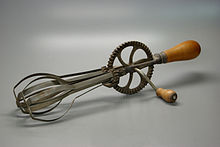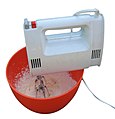Hand mixer
A hand mixer , hand mixer or kitchen mixer (sometimes also called a cream whisk ) is a hand-held kitchen device for stirring pasty or liquid food or for whipping cream . Most is two counter-rotating beaters , whisk or dough hook . Electric hand mixers were developed from floor-standing mixers ( stand mixers ) that appeared in the 1920s and 30s. The use of the linguistically imprecise term “hand mixer”, which has become common today, may have arisen from the Krups brand 3 mixers, which were widely used from the 1960s .
The development of the electric hand mixer was preceded by mechanically operated mixers that came onto the market in the second half of the 19th century. Today they are rarely used in the household.
features
Electric hand mixers usually have 2 to 5 speed levels or a stepless speed control as well as a separate eject button for the mixing tools. The connected load of the products is between 200 and 500 watts, some devices have an automatic power adjustment. A table stand and a (powered) mixing bowl can be available as accessories. As a further accessory or attachment part including a can, depending on the peripheral part of the manufacturer rod mixer (blender), a Passierstab or a universal shredder for shredding and mashing of fruit or vegetables are used. Blenders and chopper are also available as separate devices.
Kitchen history classification
prehistory
The need to whip ingredients until frothy did not develop until the Renaissance, when egg whites were discovered as a raising agent. In addition to the development of pastries loosened with egg whites or refined with egg yolk masses, desserts were also served in wealthy households of this time, the main ingredient of which was egg whites or egg yolk masses. The development of such dishes was initially not accompanied by further technical developments in the corresponding kitchen appliances. The fact that these dishes still belonged to the repertoire of wealthy households in the 17th century was due to the fact that they employed sufficient staff in their kitchens who could deal with the time-consuming whipping of egg whites, egg yolks or cream.
The whisk, with which such work can be carried out efficiently, only became an increasingly common kitchen appliance from the end of the 18th century. It cannot be ruled out that individual households produced forerunners of this kitchen appliance themselves before the 18th century, but none has survived. However, there is an illustration in the cookbook “Opera” by the Italian Renaissance chef Bartolomeo Scappi , published in 1570, which shows a kitchen appliance that is similar to today's whisk. If it was actually a whisk, this tool initially did not catch on. As recently as the 19th century, many households were not using the whisk, but other auxiliary tools to whip ingredients. A typical such auxiliary tool for whipping egg whites, egg yolks, or cream was a small bundle of debarked twigs (typically birch twigs) or even feathers tied together. While liquids could be whipped comparatively efficiently with the whisk, whipping with such aids was very time-consuming. Recipe information speaks of half an hour of work to whip up egg whites for pancakes . As late as 1823, cookbook authors Mary Eaton pointed out that three hours of work should be planned for whipping the egg whites for a large cake.
Mechanical hand mixers
The development of the hand mixer began when the number of servants employed in the household declined after the industrial revolution and at the same time technical progress in metal processing made it possible to develop inexpensive kitchen tools that reduced the amount of work. In the United States, no fewer than 692 hand mixer patents were granted in 1856 and 1920. The first hand mixer was developed in Baltimore, Maryland in 1856 by tinsmith Ralph Collier. This was followed very quickly by other developments that were patented in the USA and Europe and came onto the market. Food historian Bee Wilson compares these decades, when numerous inventors struggled to develop hand mixers, with the Dutch tulip craze in the 1630s and the euphoria of Internet start-ups in Seattle in the 1990s. The most successful patent among these inventions turned out to be the "Williams' Egg Beater" or "Dover", patented on May 31, 1870, the basic shape of which consists of two bellied whiskers driven by a handwheel, the shape of the mechanically operated ones still available today Hand mixers.
Although Wilson is of the opinion that a skillfully used whisk does not require more effort to break eggs or cream than a manually operated hand mixer, these devices were not only bought by numerous households, but also had a lasting impact on the food repertoire in medium-sized households. Dishes such as apple snow , a dessert made from applesauce and egg whites, for which four egg whites had to be whipped until they were firm, or pastries such as the “Mont Blanc Cake”, which required stiff egg whites of six egg whites, became the standard repertoire . Also Syllabubs and meringues or desserts such as Charlotte and trifle in which to meringue-based sponge cakes were processed, were widely disseminated during this time.
The Swiss product designer Alfredo Häberli invented the "Küchenblitz", a mechanical hand mixer with a transparent, closed container for Betty Bossi around 2010 .
Electric hand mixers
The electrically powered hand mixers, which gradually came onto the market in the first half of the 20th century, provided additional labor savings. They had a lasting influence on the number of dishes that could be prepared in a normal household with a reasonable amount of work.
In 1885 Rufus Eastman developed the first electric mixer and had it applied for a patent under number US330829. However, since the power grid in the USA was not yet sufficiently developed, it was not particularly widespread at first. It was not until 1908 that the engineer Herbert Johnson designed an electric 75 liter stand mixer " Hobart Model H " for the Hobart Manufacturing Company , which quickly spread to large bakeries. As early as 1919 Hobart followed suit with the " KitchenAid Hobart Model H-5 ", a model for domestic use. The first half of the 20th century was marked by further developments. The devices became smaller and more affordable. In 1952, Sunbeam brought the MixMaster, the first electrically operated hand mixer, onto the market. The hand mixer from Sunbeam corresponds in design and function to today's devices and thus laid the basis for the modern electric hand mixer.
Examples of electric hand mixers
Sound of a three-stage mixer with 130 watts, about 1980 years
literature
- Bee Wilson : Consider the Fork: A History of How We Cook and Eat . Penguin Books, London 2013, ISBN 978-0-141-04908-3 .
Single receipts
- ^ Bee Wilson: Consider the Fork . P. 212
- ↑ a b Bee Wilson: Consider the Fork . P. 213
- ^ Bee Wilson: Consider the Fork . P. 214.
- ↑ a b Bee Wilson: Consider the Fork . P. 218.
- ↑ U.S. Patent 16267 , accessed January 16, 2016
- ^ Bee Wilson: Consider the Fork . P. 219.
- ^ Bee Wilson: Consider the Fork . P. 224.
- ^ Bee Wilson: Consider the Fork . P. 221.
- ↑ US Patent 330829. November 17, 1885, accessed May 21, 2016 (English).




